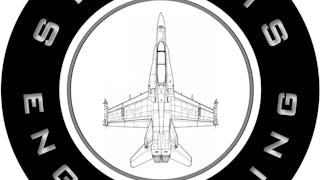In this course, you will learn what a systems engineer does. Following the conceptual foundations from The Need for Systems Engineering, you will perform requirements analysis and functional analysis on engineering programs. You will learn how to perform a trade study using a methodical, quantitative approach that is universal in application. This course also covers preparing design reviews, focusing on coordinating the inputs of multiple engineering disciplines into a cohesive description of the design approach.
通过 Coursera Plus 解锁访问 10,000 多门课程。开始 7 天免费试用。


Applying Systems Engineering to the Design Process
本课程是 Introduction to Systems Engineering 专项课程 的一部分

顶尖授课教师
3,248 人已注册
包含在 中
您将学到什么
Describe the core roles and responsibilities of a systems engineer
Define a system including its specifications, requirements, and functions
Identify decision support approaches
您将获得的技能
- Performance Measurement
- Business Requirements
- Requirements Analysis
- Data-Driven Decision-Making
- Manufacturing and Production
- Software Engineering
- Engineering Management
- Decision Making
- Engineering Design Process
- Systems Engineering
- Requirements Management
- Systems Design
- Leadership
- Design Reviews
- Systems Integration
- Coordination
- User Requirements Documents
要了解的详细信息

添加到您的领英档案
7 项作业
了解顶级公司的员工如何掌握热门技能

积累特定领域的专业知识
- 向行业专家学习新概念
- 获得对主题或工具的基础理解
- 通过实践项目培养工作相关技能
- 获得可共享的职业证书

该课程共有5个模块
We will begin the course by revisiting the topic of requirements. Now that we know what requirements are and how to write them, we will examine what requirements management is all about. On a long-duration development program, we also need a way to measure our progress from a technical standpoint toward requirement compliance. A great tool for this is to think of it in terms of Measures of Performance. At the tactical level on a design team, we will execute that by establishing a small number of Technical Performance Measures, or TPMs. These important performance attributes will keep the design team focused on the customer's most important requirements and they will help assess our progress toward meeting those objectives.
涵盖的内容
6个视频4篇阅读材料1个作业1次同伴评审1个讨论话题
In this module, will begin by describing the overall design process by tying in the concepts that we have learned to date into something that can be planned and tracked during execution. We will then learn about the "Big Three" design reviews, namely the System Requirements Review, or SRR; the Preliminary Design Review, or PDR; and the Critical Design Review, or CDR. In addition to the reviews, the Systems Engineering process also incorporates a series of audits to ensure that the documentation is all squared away. The most commonly used audits are the Functional and Physical Configuration Audits, the FCA and PCA.
涵盖的内容
4个视频3篇阅读材料2个作业
In this module, we will go over the topic of manufacturability. How do incorporate manufacturability considerations into the design process? It is considered so important that it has its own acronym, DFM, or Design for Manufacturability. We will also cover the process used for evaluating how ready a company is to scale up from low-volume development to high-volume production. In the second part of the module, we will learn about trade studies and how to conduct one.
涵盖的内容
5个视频3篇阅读材料2个作业
In this module, we are going to learn about what I call the "other engineering disciplines." I am going to group Software into this very loosely defined umbrella title with the hopes that I don't earn the ire of those who have chosen that as their profession. Rhis is more a sign of my own lack of close familiarity with the discipline. I have learned that managing development programs that include a significant software effort deserves special consideration when it comes to coordinating software development with hardware development and properly allocating time and resources to get both sides of the development effort completed. I will also cover what I call "the -illities" or the engineering disciplines like Reliability, Maintainability and others. I may even work in a few F/A-18 stories along the way!
涵盖的内容
2个视频3篇阅读材料1个作业
In this final module, we will look at how our most precious asset, our people, are assigned to a particular design effort. What are some of the important considerations that go into those decisions. We will also look at some of my favorite leadership traits from my time in the Marine Corps and how those can be applied to working in the aerospace industry. Systems Engineering is by nature a leadership role, at least at certain times, so it is important to think about leadership well before the moment we find ourselves in the spotlight.
涵盖的内容
2个视频3篇阅读材料1个作业
获得职业证书
将此证书添加到您的 LinkedIn 个人资料、简历或履历中。在社交媒体和绩效考核中分享。
攻读学位
课程 是 University of Colorado Boulder提供的以下学位课程的一部分。如果您被录取并注册,您已完成的课程可计入您的学位学习,您的学习进度也可随之转移。
位教师

从 Leadership and Management 浏览更多内容
 状态:免费试用
状态:免费试用University of Colorado Boulder
 状态:免费试用
状态:免费试用University of Colorado Boulder
 状态:免费试用
状态:免费试用University of Colorado Boulder
 状态:预览
状态:预览MathWorks
人们为什么选择 Coursera 来帮助自己实现职业发展




学生评论
34 条评论
- 5 stars
79.41%
- 4 stars
17.64%
- 3 stars
2.94%
- 2 stars
0%
- 1 star
0%
显示 3/34 个
已于 Apr 6, 2025审阅
An Excellent Course!!!
常见问题
To access the course materials, assignments and to earn a Certificate, you will need to purchase the Certificate experience when you enroll in a course. You can try a Free Trial instead, or apply for Financial Aid. The course may offer 'Full Course, No Certificate' instead. This option lets you see all course materials, submit required assessments, and get a final grade. This also means that you will not be able to purchase a Certificate experience.
When you enroll in the course, you get access to all of the courses in the Specialization, and you earn a certificate when you complete the work. Your electronic Certificate will be added to your Accomplishments page - from there, you can print your Certificate or add it to your LinkedIn profile.
Yes. In select learning programs, you can apply for financial aid or a scholarship if you can’t afford the enrollment fee. If fin aid or scholarship is available for your learning program selection, you’ll find a link to apply on the description page.
更多问题
提供助学金,



